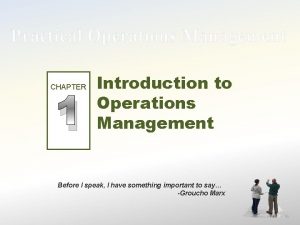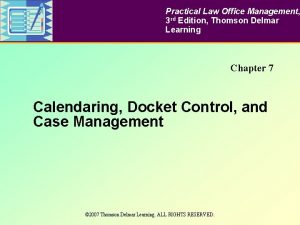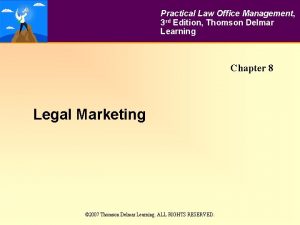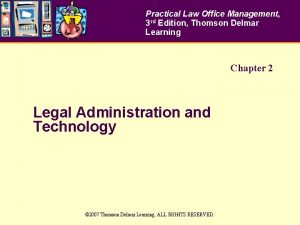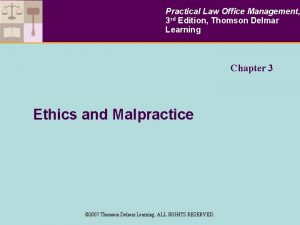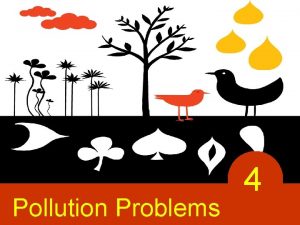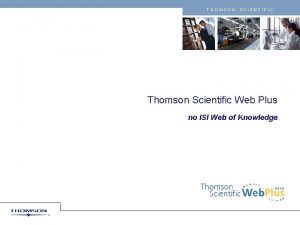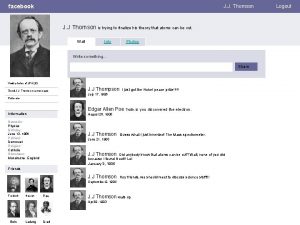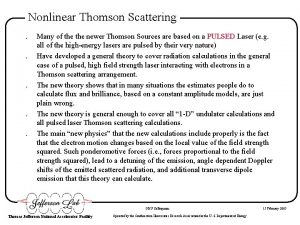Practical Law Office Management 3 rd Edition Thomson






















- Slides: 22

Practical Law Office Management, 3 rd Edition, Thomson Delmar Learning Chapter 4 Client Relations and Communication Skills © 2007 Thomson Delmar Learning. ALL RIGHTS RESERVED.

Attorneys’ Ethical Duty to Communicate with Clients Model Rules of Professional Conduct Rule 1. 4 Communication a) A lawyer shall: (1) Promptly inform the client of any decision or circumstance with respect to which the client’s informed consent, as defined in rule 1. 0(e), is required by these rules; (2) Reasonably consult with the client about the means by which the client’s objectives are to be accomplished; (3) Keep the client reasonably informed about the status of the matter; (4) Promptly comply with reasonable requests for information; and (5) Consult with the client about any relevant limitation on the lawyer’s conduct when the lawyer knows that the client expects assistance not permitted by the rules of professional conduct or other law. (B) A lawyer shall explain a matter to the extent reasonably necessary to permit the client to make informed decisions regarding the representation. 2 © 2007 Thomson Delmar Learning. ALL RIGHTS RESERVED.

Attorneys’ Ethical Duty to Communicate with Clients Generally an attorney must: • Inform a client on the status of his or her case. • Timely respond to a client’s request for information. • Inform clients promptly about important information. • Not cover up a matter if he or she failed to carry out the client’s instructions. • Notify a client if the attorney is leaving a firm or quitting the practice of law. • Notify a client if he or she is stopping work on a client’s case. • Explain the law, and benefits and risks of alternative courses of action. • Notify and communicate settlement offers to clients. 3 © 2007 Thomson Delmar Learning. ALL RIGHTS RESERVED.

Client Relationships Ways to foster positive client relationships: • Treat each client as if he or she were your only client. • Send copies of all documents produced for the client’s case to the client. • Do not use legalese. • Return client phone calls immediately. • Be courteous, empathetic, and professional at all times. • Respond to client requests in a timely fashion, and keep your promises. 4 © 2007 Thomson Delmar Learning. ALL RIGHTS RESERVED.

Client Relationships Ways to foster positive client relationships: • Give clients routine, periodic status reports on their cases. • Do not share personal or office problems with clients. • Preserve client confidences. • Use client surveys to gain insight into client needs. • Publish a client manual. • Take conflicts seriously, and be ethical. • Do not procrastinate. 5 © 2007 Thomson Delmar Learning. ALL RIGHTS RESERVED.

Client Relationships What Clients Like What Clients Dislike Friendliness Being talked down to Competence Arrogance Promptness Staff acting bored or uninterested Being able to reach attorneys/ staff on the first try Impatience Excellent follow-up Rudeness Not being billed for every two-minute phone call Calls and e-mails not returned Attorneys/staff taking extra time to explain the legal process in layperson’s terms Incorrect billings 6 © 2007 Thomson Delmar Learning. ALL RIGHTS RESERVED.

Client Relationships What Clients Like What Clients Dislike Listening and paying attention to what the client has to say Being forgotten, treated as unimportant, or taken for granted Demonstrating genuine interest in the client’s problems and concerns year in and year out Confidentiality breaches Honesty Errors Good financial stewardship Poor-quality work Completing work on time Multiple staff billing for the same event Waiting in the waiting room when they have an appointment and are on time 7 © 2007 Thomson Delmar Learning. ALL RIGHTS RESERVED.

Client Relationships – Know Your Client • • When dealing with the client, take into account his or her emotional/mental/physical state. Establish basic trust in the relationship at every opportunity by listening to their needs, being honest, and being respectful. Ask your clients what their concerns are about the matter. Ask your clients what their businesses are about. Do research on your own about their businesses and industries. Ask how they prefer to be communicated with (in person, e-mail, telephone, voice mail, etc. ) Ask them how often they want to be communicated with. Ask how you can serve them better periodically. 8 © 2007 Thomson Delmar Learning. ALL RIGHTS RESERVED.

Client Relationships – Treat Each Client as if He or She Is Your Only Client • • • When you meet with a client, only have his or her file on your desk. Never take another call when meeting with a client, and let others know not to disturb you. Never talk about how busy you are or about other cases to clients. Particularly with new clients, it is important that the initial meeting go well and that law office staff are immediately available after a referral is made. Particularly with new clients, be sure and mention whether the firm has handled similar cases in the past. Clients like to know the firm is experienced regarding the subject matter of their case. 9 © 2007 Thomson Delmar Learning. ALL RIGHTS RESERVED.

Client Relationships • • • Send copies of all documents to clients. Do not use legalese. Return all phone calls, and reply to e-mails and voice mails immediately. Be courteous and professional. Respond to clients requests, and keep promises. Give periodic updates. Never share personal problems or complain to clients. Preserve client confidences. Survey clients. 10 © 2007 Thomson Delmar Learning. ALL RIGHTS RESERVED.

Client Relationships Management must help promote good client relations. • Publish a client manual. • Take conflicts of interests seriously, and be ethical. • Do not procrastinate. • 11 © 2007 Thomson Delmar Learning. ALL RIGHTS RESERVED.

Client Relationships – Resolving Client Dissatisfaction Strategies for resolving client dissatisfaction: • Empathetically listen to the complaint; do not interrupt, and do not argue. • Do not overstep your bounds or promise something you cannot deliver. • Take notes. • Forward complaints to your supervising attorney, and be honest. • Do not ignore the complaint. • Realize that some clients will always complain. • Realize that you may have personality conflicts with some clients. 12 © 2007 Thomson Delmar Learning. ALL RIGHTS RESERVED.

Client Relationships Technology Clients are demanding greater use of technology to serve them. • E-mail attachments (particularly Microsoft Office products, since this is what many corporations and individuals use) • Extranet • Attorneys’ and legal professionals’ mobile phone numbers • Electronic billing 13 © 2007 Thomson Delmar Learning. ALL RIGHTS RESERVED.

Client Relationships – Why Do Clients Leave? Why Clients Leave Law Offices Percent Death 1% Move 3% Dislike the product 5% Have a dispute that is not addressed or corrected 24% Feel they were treated discourteously, indifferently, 67% or were simply not given good service 14 © 2007 Thomson Delmar Learning. ALL RIGHTS RESERVED.

Client Relationships – Difficult Clients Stay calm and maintain professionalism. Document conversations. Be courteous, but maintain an arm’s-length relationship. Keep the attorney fully informed. • • 15 © 2007 Thomson Delmar Learning. ALL RIGHTS RESERVED.

Improving Communication Skills • • • Listen. Consider your nonverbal signals, such as how you are dressed, whether or not you are fidgeting, or if you have your hands in your pockets. Do not become emotional. Make eye contact. Be precise and clear, so nothing is left to the imagination. Tailor the content of your communication for your audience. Consider the timing and context of your communication. Do not be judgmental/avoid negatives. Ask questions. Rephrase things. 16 © 2007 Thomson Delmar Learning. ALL RIGHTS RESERVED.

10 Commandments of Good Listening 1. STOP TALKING! • You cannot listen if you are talking. 2. PUT THE TALKER AT EASE. • Help the person feel that he or she is free to talk. 3. SHOW THE INDIVIDUAL THAT YOU WANT TO LISTEN. • Look and act interested. Do not read your e-mail while the person talks. Listen to understand, rather than to oppose. 4. REMOVE DISTRACTIONS. • Do not doodle, tap, or shuffle papers. 5. EMPATHIZE WITH THE PERSON. • 17 Try to see the other person’s point of view. © 2007 Thomson Delmar Learning. ALL RIGHTS RESERVED.

10 Commandments of Good Listening 6. BE PATIENT. • Allow plenty of time. Do not interrupt. Don’t start for the door or walk away. 7. HOLD YOUR TEMPER. • An angry person gets the wrong meaning from words. 8. GO EASY ON ARGUMENT AND CRITICISM. • This puts the person on the defensive. He or she may “clam up” or get angry. Do not argue: even if you win, you lose. 9. ASK QUESTIONS. • This encourages the speaker and shows that you are listening. It also helps to develop points further. 10. STOP TALKING! • SOURCE: Davis, K. (1972). Human behavior at work (4 th ed. ). © 1972, Mc. Graw-Hill. Reprinted with permission of Mc. Graw-Hill. 18 © 2007 Thomson Delmar Learning. ALL RIGHTS RESERVED.

Traits of a Leader • • 19 Be an expert on what you are talking about. People around you will develop confidence in your abilities and rely upon your judgment and knowledge. Be honest. Develop a reputation for honesty and integrity. Stay calm. Good leaders stay calm under fire. Trust and support subordinates. Take risks, and do not be afraid to fail. Encourage honest opinions from others. Set goals and visions. Be respectful. © 2007 Thomson Delmar Learning. ALL RIGHTS RESERVED.

Advantages of Group Communication Groups tend to make more accurate decisions, since they have a greater perspective. • When a group makes a decision, it can be implemented easier than if made alone. • Group members can explain the group’s decision, since they were included in the process. • 20 © 2007 Thomson Delmar Learning. ALL RIGHTS RESERVED.

Disadvantages of Group Communication • • • 21 Decisions made by groups take up to 50% longer than decisions made by individuals. Group decisions are often compromises rather than the most appropriate option. “Groupthink” can occur. Groupthink is where group cohesiveness and consensus becomes stronger than the desire for the best possible decision. Groups sometimes make more risky decisions than individuals. Groups can be dominated by one or more individuals. © 2007 Thomson Delmar Learning. ALL RIGHTS RESERVED.

Interviewing • • • Prepare for the interview. Break the ice. Always inform the person you are interviewing that you are a legal assistant. Listen carefully. Communicate sincerity. Be empathetic. Organize the information. Ask questions. Do not be judgmental. Never say “You have a great case. ” Leave fee discussions to the attorney. 22 © 2007 Thomson Delmar Learning. ALL RIGHTS RESERVED.
 Kinicki: management: a practical introduction 3rd edition
Kinicki: management: a practical introduction 3rd edition Using mis 10th edition
Using mis 10th edition Mis
Mis Newton's first law and second law and third law
Newton's first law and second law and third law Newton's first law and second law and third law
Newton's first law and second law and third law Boyle's law charles law avogadro's law
Boyle's law charles law avogadro's law How to calculate boyle's law
How to calculate boyle's law Other practical applications of boyle's law
Other practical applications of boyle's law Real life examples of charles law
Real life examples of charles law Managing front office operations 10th edition
Managing front office operations 10th edition Practical operations
Practical operations Practical investment management
Practical investment management Angelo kinicki management: a practical introduction
Angelo kinicki management: a practical introduction Read management: a practical introduction
Read management: a practical introduction Practical financial management
Practical financial management Management a practical introduction
Management a practical introduction Management a practical introduction 3e
Management a practical introduction 3e Medical law and ethics 5th edition
Medical law and ethics 5th edition Medical law and ethics 5th edition
Medical law and ethics 5th edition Medical law and ethics 5th edition
Medical law and ethics 5th edition Florida real estate principles practices & law 43rd edition
Florida real estate principles practices & law 43rd edition Florida real estate principles practices
Florida real estate principles practices Office and factory
Office and factory










